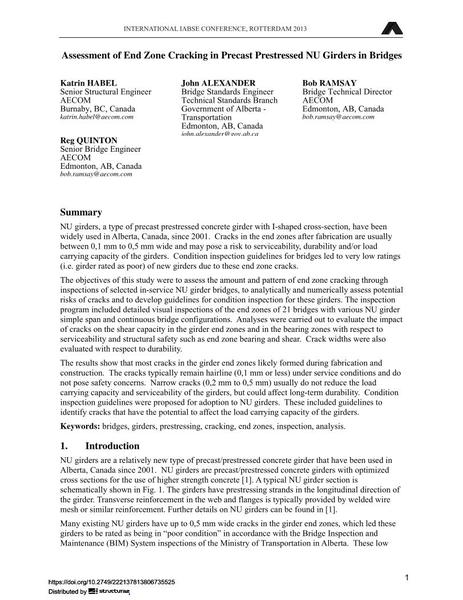Assessment of End Zone Cracking in Precast Prestressed NU Girders in Bridges

|
|
|||||||||||
Détails bibliographiques
| Auteur(s): |
Katrin Habel
John Alexander Bob Ramsay Reg Quinton |
||||
|---|---|---|---|---|---|
| Médium: | papier de conférence | ||||
| Langue(s): | anglais | ||||
| Conférence: | IABSE Conference: Assessment, Upgrading and Refurbishment of Infrastructures, Rotterdam, The Netherlands, 6-8 May 2013 | ||||
| Publié dans: | IABSE Conference, Rotterdam, May 2013 | ||||
|
|||||
| Page(s): | 210-211 | ||||
| Nombre total de pages (du PDF): | 8 | ||||
| Année: | 2013 | ||||
| DOI: | 10.2749/222137813806735525 | ||||
| Abstrait: |
NU girders, a type of precast prestressed concrete girder with I-shaped cross-section, have been widely used in Alberta, Canada, since 2001. Cracks in the end zones after fabrication are usually between 0,1 mm to 0,5 mm wide and may pose a risk to serviceability, durability and/or load carrying capacity of the girders. Condition inspection guidelines for bridges led to very low ratings (i.e. girder rated as poor) of new girders due to these end zone cracks. The objectives of this study were to assess the amount and pattern of end zone cracking through inspections of selected in-service NU girder bridges, to analytically and numerically assess potential risks of cracks and to develop guidelines for condition inspection for these girders. The inspection program included detailed visual inspections of the end zones of 21 bridges with various NU girder simple span and continuous bridge configurations. Analyses were carried out to evaluate the impact of cracks on the shear capacity in the girder end zones and in the bearing zones with respect to serviceability and structural safety such as end zone bearing and shear. Crack widths were also evaluated with respect to durability. The results show that most cracks in the girder end zones likely formed during fabrication and construction. The cracks typically remain hairline (0,1 mm or less) under service conditions and do not pose safety concerns. Narrow cracks (0,2 mm to 0,5 mm) usually do not reduce the load carrying capacity and serviceability of the girders, but could affect long-term durability. Condition inspection guidelines were proposed for adoption to NU girders. These included guidelines to identify cracks that have the potential to affect the load carrying capacity of the girders. |
||||
| Mots-clé: |
ponts
|
||||
